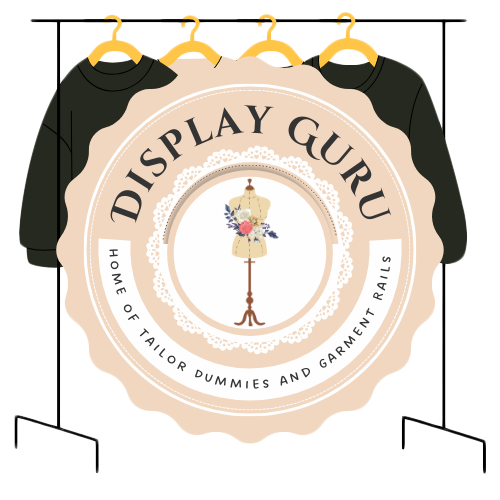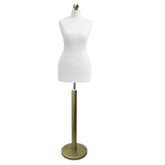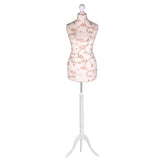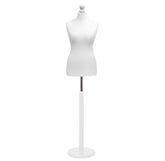10 Essential Retail Display Solutions to Boost Sales in 2025
Revolutionising Your Retail Space: Beyond the Shelf
In the competitive retail landscape, simply having excellent products is no longer enough. The customer experience is paramount, and it begins the moment a potential buyer engages with your space. Effective retail display solutions are not merely about organising stock; they are a powerful, non-verbal form of salesmanship. They communicate your brand’s story, guide the customer journey, and are instrumental in converting passive browsers into active, loyal customers.
From the strategic psychology of colour and placement to the functional elegance of a well-chosen garment rail, the right displays can dramatically increase engagement, boost average transaction value, and build lasting brand affinity. A thoughtfully arranged window display can stop passers-by in their tracks, while a clever endcap can introduce them to products they never knew they needed. The goal is to create a cohesive, immersive, and shoppable environment that resonates with your target audience, whether they are fashion designers seeking inspiration or retail owners looking to maximise their floor space.
This comprehensive guide moves beyond generic advice to provide actionable strategies and best practices for implementing a variety of powerful display techniques. We will explore ten critical types of retail display solutions, from dynamic Point of Purchase (POP) setups to immersive brand shop-in-shops. You will learn how to leverage each type to its fullest potential, transforming your physical store into an inspiring destination that not only showcases products but also drives significant commercial success. Prepare to rethink your floor plan and unlock the full potential of your visual merchandising strategy.
1. Point of Purchase (POP) Displays
Point of Purchase (POP) displays are among the most powerful retail display solutions for driving unplanned purchases. Strategically placed in high-traffic, decision-making zones like checkout counters or service desks, these displays are designed to capture customer attention at the critical moment of transaction. Their primary function is to trigger impulse buying by showcasing complementary items, special offers, or convenient grab-and-go products when customers have their wallets ready. This last-minute influence can significantly boost average transaction value and introduce customers to new items.
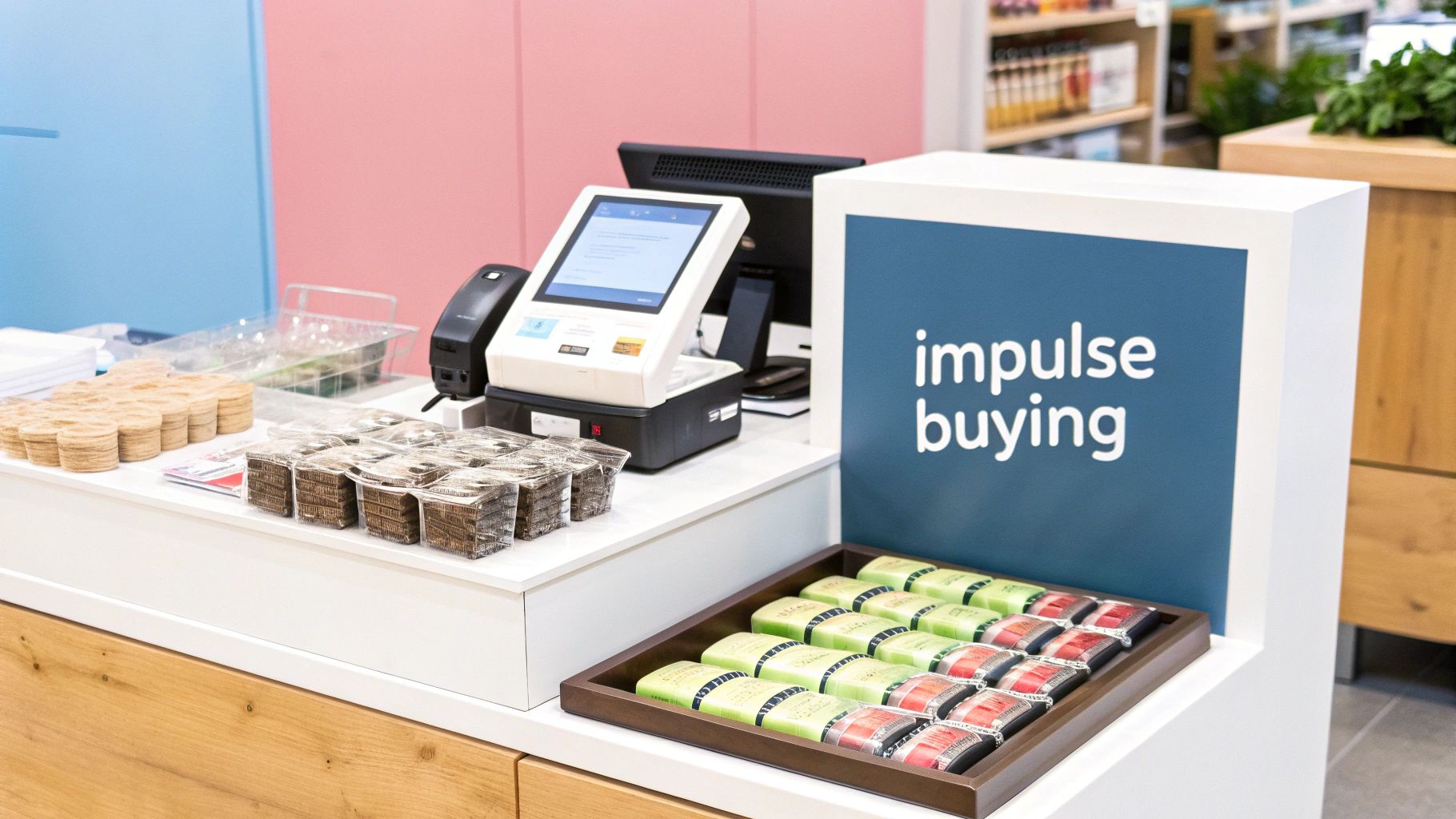
POP displays excel by capitalising on customer psychology. For instance, a pharmacy placing travel-sized toiletries at the till targets customers preparing for a trip or those seeking convenient sizes. Similarly, electronics retailers position phone cases and screen protectors near payment points, reminding customers to protect their new, expensive device. These are not random placements; they are calculated moves based on consumer behaviour and product relevance.
Best Practices for Implementation
To maximise the effectiveness of your POP displays, consider the following actionable tips:
- Strategic Positioning is Key: Place displays at or slightly below eye level (around 1.5 metres from the floor) for optimal visibility. Ensure they are positioned within the natural queueing path but do not obstruct customer flow or create congestion, which can frustrate shoppers.
- Maintain Relevance and Freshness: Rotate products seasonally or for special events to keep the display looking fresh and relevant. A display featuring small, giftable items in December will perform better than one showcasing sun cream.
- Test and Optimise: Don't be afraid to experiment with different product combinations. Track sales data from your POP displays to identify which items or bundles generate the most revenue. Use A/B testing by changing one element, like the featured product or signage, and measure the impact on sales.
- Clear, Compelling Signage: Use bold, simple messaging and clear pricing. Signs that highlight a special offer, like "2 for £5" or "Add for just £1," are highly effective at prompting immediate action.
By thoughtfully curating and positioning these units, retailers can transform otherwise passive waiting areas into active, revenue-generating zones. For a deeper dive into the variety of stands available, you can explore more about the strategic use of retail display stands.
2. Digital Signage and Interactive Displays
Digital signage and interactive displays represent the evolution of in-store communication, transforming static retail spaces into dynamic, engaging environments. These modern retail display solutions leverage electronic screens, LED technology, and interactive kiosks to deliver content that can be updated in real-time. From simple digital price tags to sophisticated touchscreens offering product customisation, their primary role is to captivate, inform, and interact with the modern shopper, providing a seamless bridge between the physical and digital retail experience.
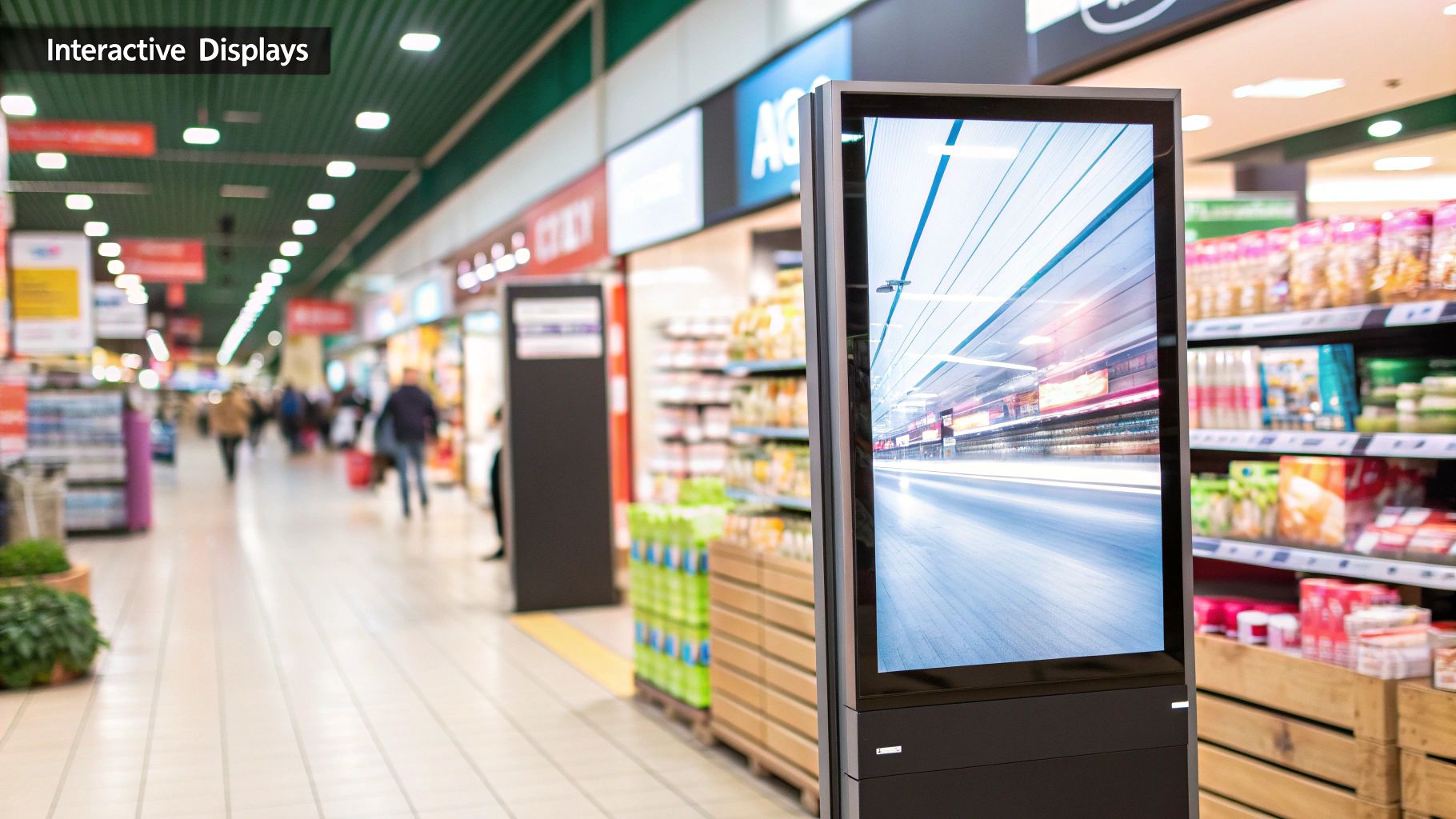
The power of these displays lies in their versatility and ability to provide rich, tailored experiences. For example, Sephora's virtual try-on stations use augmented reality to let customers experiment with makeup digitally, reducing hygiene concerns and increasing engagement. Similarly, Nike uses interactive displays to allow shoppers to customise trainers in-store, creating a personalised product and a memorable brand interaction. These technologies are not just gimmicks; they are powerful tools for educating consumers, streamlining service through self-ordering kiosks, and gathering valuable customer data.
Best Practices for Implementation
To harness the full potential of digital and interactive displays, focus on strategic deployment and content quality:
- Ensure Content is Relevant and Dynamic: The key advantage of digital is its ability to change. Keep content fresh by updating it for promotions, new arrivals, or seasonal campaigns. Stale, outdated content will quickly be ignored by customers.
- Prioritise Visibility and Accessibility: Position screens at a comfortable eye level, typically between 1.5 and 1.7 metres from the floor. Use high-contrast colours and large, legible fonts to ensure messages are easily readable from a distance and in various lighting conditions.
- Include a Clear Call-to-Action: Every display should guide the customer towards a specific action. Use clear, concise messaging like "Scan Here for 10% Off," "Touch to Explore," or "Watch Our Story" to direct engagement and measure effectiveness.
- Regularly Test Functionality: Interactive displays must be flawless. Routinely check that touchscreens are responsive, software is running smoothly, and all features are working as intended. A non-functional display is worse than no display at all, as it reflects poorly on the brand.
By integrating these advanced systems, retailers can create a more immersive and responsive shopping journey, ultimately driving sales and fostering stronger brand loyalty. For an in-depth look at how technology is shaping retail environments, you can learn more about innovations in shop fitting.
3. Endcap Displays
Endcap displays are prime retail real estate, positioned at the very end of store aisles where shopper traffic is highest. These prominent fixtures act as powerful billboards within the store, capitalising on the natural pause points in a customer's journey. They are ideal retail display solutions for launching new products, highlighting seasonal promotions, or showcasing high-margin items. Their high visibility ensures that promotions or key products are seen by nearly every customer who walks down the main thoroughfares of a store, driving significant sales and brand awareness.
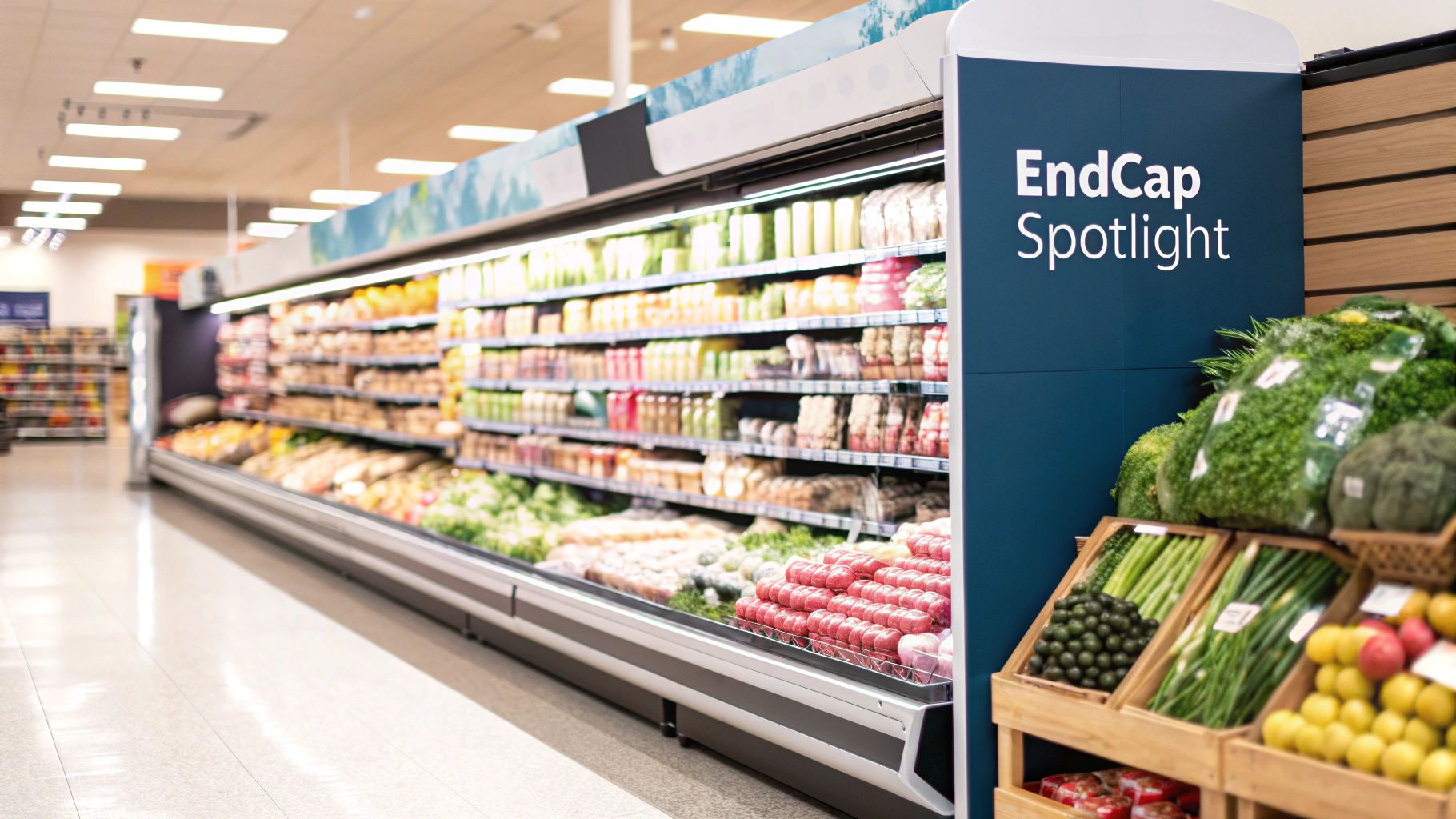
The strategic power of an endcap lies in its ability to disrupt the routine shopping pattern. For example, a supermarket using an endcap for a Coca-Cola holiday promotion creates an unmissable, festive focal point. Similarly, a DIY store like Home Depot might feature seasonal lawn care products at the end of an aisle in spring, capturing the attention of customers who may not have planned to visit that specific aisle. This exposure makes endcaps incredibly effective for cross-selling and introducing shoppers to items outside of their planned purchase list.
Best Practices for Implementation
To maximise the return on this valuable retail space, consider the following actionable tips:
- Create a Thematic Display: Feature complementary products together to encourage multiple purchases. For instance, a back-to-school endcap could bundle notebooks, pens, and backpacks, creating a one-stop-shop solution for parents.
- Use Bold, 360-Degree Signage: Your signage must be large, clear, and visible from the front and sides as customers approach from different directions. Use compelling visuals and concise messaging to communicate the offer or product benefit instantly.
- Rotate and Refresh Regularly: Keep your endcaps dynamic by changing them every two to four weeks. This creates a sense of urgency and encourages repeat customers to check what's new. Align the rotation with seasonal events, holidays, or store-wide marketing campaigns.
- Monitor Stock Levels Diligently: Due to their high visibility and sales velocity, endcap displays can sell out quickly. Ensure they are well-stocked, clean, and organised at all times to avoid a poor customer impression and lost sales opportunities. An empty display is a wasted opportunity.
4. Window Displays
Window displays are a retailer's primary tool for making a powerful first impression, acting as a visual handshake to entice passersby into the store. These carefully curated storefront showcases combine lighting, props, mannequins, and hero products to tell a compelling brand story. Their main goal is to create an emotional connection and generate curiosity, transforming foot traffic on the pavement into footfall through the door. A well-executed window display is more than just product placement; it's a piece of street-side theatre that sets the tone for the entire shopping experience.
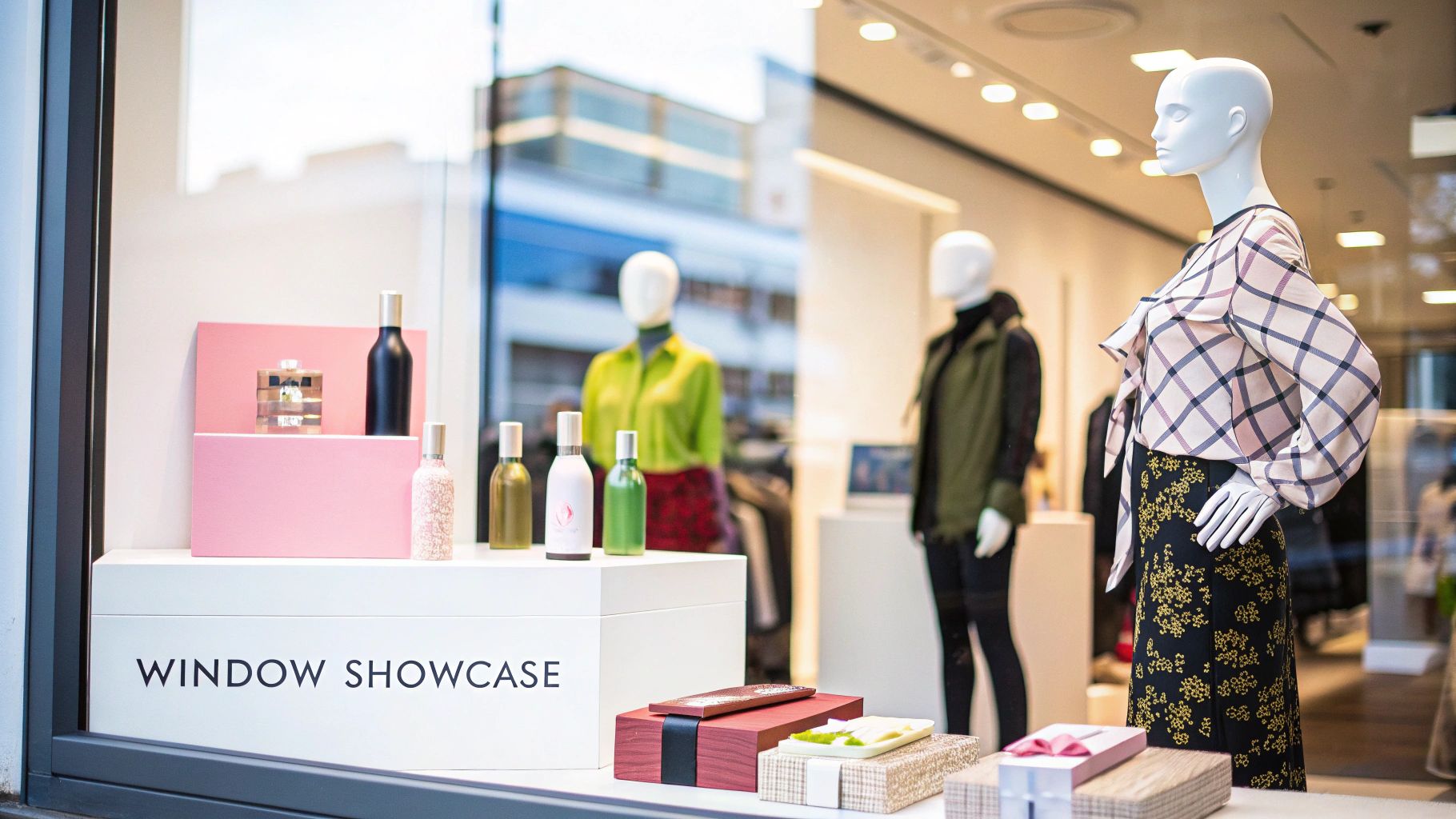
The power of a window display lies in its ability to communicate a brand's identity instantly. For example, the minimalist product showcases in an Apple Store window convey modernity and simplicity, while a local boutique’s seasonal fashion display might evoke a sense of warmth and community. Iconic retailers like Bergdorf Goodman have elevated this practice to an art form with their elaborate, artistic presentations, proving that these displays are one of the most essential retail display solutions for establishing brand prestige and drawing in a target audience.
Best Practices for Implementation
To maximise the impact of your window displays, consider these actionable strategies:
- Establish a Clear Focal Point: Use the rule of thirds to draw the eye to a key product or mannequin. Avoid clutter, as a chaotic display can confuse potential customers and dilute your message. The goal is to create a single, strong visual statement.
- Leverage Dynamic Lighting: Use a combination of spotlights to highlight featured items and ambient light to create mood. Coloured lighting can be used to reflect seasonal themes or brand colours, making the display stand out, especially after dark.
- Create Depth and Layers: Arrange props and products at different depths, from close to the glass to the back of the display area. This layering technique creates visual interest and makes the scene feel more dynamic and immersive.
- Maintain a Regular Refresh Cycle: Change your window displays every two to four weeks to keep them looking fresh and give regular passersby a new reason to look. Stale displays can suggest a stale inventory and a lack of innovation.
By treating your shop window as a stage, you can captivate audiences and drive significant customer engagement. For inspiration on creating flexible in-store scenes, you can discover more about the uses of a portable clothing rack for dynamic merchandising.
5. Product Demonstration Stations
Product demonstration stations are highly effective retail display solutions that bridge the gap between browsing and buying. These are interactive areas where customers can experience products firsthand through guided demonstrations, self-service testing, or hands-on trials. By allowing shoppers to see, touch, and use a product, these stations demystify complex items and build confidence, directly influencing purchasing decisions. They are especially powerful for products where the value is best understood through experience rather than just packaging.
These stations transform passive shopping into an active, engaging event. Think of an Apple Store, where customers freely test every device, or a Williams Sonoma, where live cooking demonstrations fill the air with enticing aromas and show high-end appliances in action. Similarly, cosmetics retailers like Sephora use makeup application counters to help customers find their perfect shade, creating a personalised experience that drives both sales and loyalty. These setups are calculated to immerse the customer and prove a product's worth in a tangible way.
Best Practices for Implementation
To get the most out of your product demonstration stations, consider these actionable strategies:
- Schedule Demonstrations Strategically: Plan live demonstrations during your store’s peak traffic hours, such as weekends or weekday evenings. Promote the schedule in advance via social media or in-store signage to attract an audience.
- Empower Staff, Don't Push: Train your demonstration staff to be knowledgeable and helpful guides, not aggressive salespeople. Their role is to facilitate the experience, answer questions, and highlight benefits, allowing the product to sell itself.
- Maintain Impeccable Hygiene: A clean and well-maintained station is crucial, especially for hands-on products. Regularly sanitise surfaces, restock consumables, and provide hand sanitiser or cleaning supplies to ensure customers feel comfortable and safe.
- Gather Actionable Feedback: Use the station as an opportunity to collect direct customer feedback. Ask visitors about their experience, what they liked, and what could be improved. This insight is invaluable for refining both the product and the demonstration itself.
By creating an environment of discovery and education, retailers can forge stronger customer connections and showcase product value in a way that static displays cannot. For those in fashion or tailoring, understanding how to perfectly present items is key, which shares principles with creating a good demonstration; explore more on how an adjustable mannequin can be your ultimate fitting guide.
6. Planogram-Based Shelf Displays
Planogram-based shelf displays represent a highly systematic approach to retail merchandising. Rather than arranging products arbitrarily, these displays follow a detailed schematic diagram, or planogram, which dictates the precise placement, facing, and quantity of each item on the shelf. This data-driven strategy leverages sales analytics, customer behaviour insights, and category management principles to create an organised, shoppable, and profitable retail environment. The core goal is to maximise sales per square foot while simultaneously ensuring logical product organisation and efficient inventory management.
This methodical approach enhances the customer journey by making products easy to find and logically grouped. For example, a supermarket like Whole Foods uses planograms to organise its organic produce sections, ensuring seasonal items are prominent and complementary goods are nearby. Similarly, large retailers like Target implement precise planograms for seasonal transitions, allowing for a swift and consistent changeover of products from Halloween to Christmas across hundreds of stores, providing a uniform and predictable shopping experience.
Best Practices for Implementation
To harness the full potential of planogram-based retail display solutions, retailers should focus on disciplined execution and continuous analysis:
- Prioritise High-Margin Items: Use the prime "eye-level" shelf space (often called the "bullseye zone") for your most profitable products or bestsellers. Placing these items directly in the customer's line of sight dramatically increases their visibility and likelihood of purchase.
- Group Complementary Products: Arrange items that are frequently bought together in close proximity. For instance, in a DIY store, placing sandpaper and wood varnish next to paintbrushes creates a convenient shopping solution, encouraging add-on sales.
- Utilise Vertical Space: Think vertically, not just horizontally. Use tiered risers or different shelf heights to create visual interest and break up the monotony of a flat wall of products. This technique, known as vertical merchandising, can guide the customer's eye across the entire product range.
- Analyse and Adapt: A planogram is not a "set and forget" tool. Regularly analyse sales data to identify slow-moving items and bestsellers. Use this information to refine and optimise your layouts to reflect current purchasing trends and seasonality.
- Ensure Staff Training: Proper execution is critical. Train your team to understand the importance of the planogram and how to implement it accurately. Consistency across all shelves and stores is key to realising the benefits.
By implementing these strategies, retailers can transform standard shelving into a powerful sales tool. You can find more practical advice by exploring these visual merchandising guidelines.
7. Seasonal and Holiday Displays
Seasonal and holiday displays are powerful, time-sensitive retail display solutions that leverage specific celebrations, seasons, and cultural events to create an immersive shopping experience. By aligning products with customers' immediate needs and festive moods, these displays generate excitement, urgency, and a strong emotional connection. They transform sections of a store into thematic destinations, encouraging themed purchasing and driving sales for products relevant to a particular time of year.
These displays work by tapping into the collective consciousness surrounding events like Christmas, Halloween, or the back-to-school period. For example, a department store creating a "Christmas Grotto" with themed decorations, gift wrap, and curated presents creates a one-stop-shop for festive needs. Similarly, a supermarket dedicating an aisle to Valentine's Day with chocolates, flowers, and cards simplifies the gift-buying process. The success of these displays lies in their ability to anticipate and cater to the specific purchasing missions of shoppers during these peak periods.
Best Practices for Implementation
To execute effective seasonal and holiday displays, focus on timely planning and engaging presentation:
- Plan Transitions Well in Advance: Begin planning your seasonal displays 6-8 weeks ahead. This provides ample time to source products, design the layout, and prepare marketing materials, ensuring a smooth transition without last-minute chaos.
- Use Modular and Adaptable Fixtures: Employ modular retail display solutions that can be easily reconfigured. This allows you to adapt the same core fixtures for a Halloween costume centre one month and a Christmas gift hub the next, saving costs and reducing setup time.
- Start Early but Maintain Freshness: Launch your seasonal promotions early to capture eager shoppers, but continuously refresh the display with new stock or updated offers. This prevents the display from becoming stale and encourages repeat visits throughout the season.
- Develop a Clear Markdown Strategy: Have a clear plan for post-season inventory. An organised markdown and clearance strategy implemented immediately after the event maximises recovery on unsold stock and frees up valuable floor space for the next campaign.
8. Cross-Merchandising Displays
Cross-merchandising is a powerful retail strategy that involves grouping complementary products from different categories together. This approach moves beyond simple product placement to create intuitive, solution-oriented shopping experiences. By anticipating a customer's needs and placing related items side-by-side, retailers can significantly increase average transaction values and enhance customer convenience. This technique leverages natural product associations to prompt additional, often unplanned, purchases.
This method works by solving a problem for the shopper before they even realise they have it. For example, a display of phone cases and screen protectors next to a new smartphone display reminds the customer to protect their investment immediately. Similarly, placing batteries near electronic toys during the holiday season, or positioning coffee filters next to coffee beans, simplifies the shopping journey. These thoughtful pairings demonstrate an understanding of the customer's lifestyle and end goals, fostering loyalty and driving sales.
Best Practices for Implementation
To implement effective cross-merchandising displays, consider these actionable strategies:
- Analyse Purchase Data: Dive into your sales data to identify which products are frequently bought together. This data-driven approach removes guesswork and reveals genuine customer purchasing habits, providing a solid foundation for your pairings.
- Use Clear, Contextual Signage: Create signage that explicitly explains the connection between the products. A sign like, "Don't Forget the Batteries!" or "The Perfect Sauce for Your Pasta," provides a clear call to action and highlights the convenience you are offering.
- Test and Refine Combinations: The most effective pairings may not always be the most obvious. Experiment with different product combinations and monitor their performance. Use A/B testing on a small scale to see which pairings resonate most with your customers before rolling them out store-wide.
- Monitor Inventory Levels: A key challenge with cross-merchandising is managing stock for two separate product categories in one location. Ensure you have a robust system to monitor and replenish both items to avoid customer frustration from an out-of-stock component.
By strategically curating these displays, retailers can transform a standard shopping trip into a helpful, guided experience, making it one of the most intelligent retail display solutions for boosting basket size.
9. Brand Shop-in-Shop Displays
Brand shop-in-shop displays are dedicated retail spaces within larger stores designed to recreate the specific branded experience of a manufacturer or designer. These displays function as immersive mini-stores, featuring comprehensive product lines, brand-specific fixtures, and curated environments. This powerful strategy maintains brand integrity and offers a unique customer experience while leveraging the host retailer's foot traffic, infrastructure, and established customer base. This approach is one of the most sophisticated retail display solutions for building brand loyalty in a multi-brand environment.
These installations go beyond simple product placement. They create a destination. For example, the Apple sections within electronics retailers or the Sephora shops inside department stores are not just shelves of products; they are carefully controlled environments. They use specific lighting, fixtures, and trained staff to replicate the brand's standalone store experience, offering customers a deep-dive into the brand's world without them having to visit a separate location.
Best Practices for Implementation
To successfully execute a shop-in-shop display, a strong partnership and meticulous attention to detail are essential:
- Strictly Adhere to Brand Guidelines: The core benefit is brand consistency. Ensure all elements, from the colour of the fixtures to the font on the signage, perfectly match the brand's official guidelines to create an authentic experience.
- Invest in Brand-Specific Staff Training: Staff in this area should be experts on the brand's products, history, and values. This specialised knowledge elevates the customer service level and reinforces brand authority.
- Create Clear Navigation and Sightlines: The shop-in-shop must be clearly visible and easily accessible from the main store aisles. Use distinct flooring, overhead signage, or architectural elements to define the space and draw customers in.
- Synchronise with Brand Campaigns: The display must stay current. Regularly update visuals, product assortments, and promotional messaging to align with the brand’s wider marketing campaigns, new launches, and seasonal pushes. This ensures the space feels dynamic and relevant.
By integrating these dedicated zones, retailers can attract new demographics and enhance their store's appeal, while brands can expand their physical reach. This thoughtful approach to representation is similar to how brands consider inclusivity in their marketing, for instance by exploring options like plus-size mannequins for stylish and inclusive store displays.
10. Pop-Up and Temporary Displays
Pop-up and temporary displays are dynamic, short-term retail installations that offer flexibility and generate excitement. These retail display solutions are designed to capitalise on seasonal trends, test new products, or create exclusive brand experiences without the commitment of a permanent physical location. Ranging from small kiosks in shopping centres to fully-fledged pop-up shops in vacant retail spaces, they create a powerful sense of urgency and scarcity that can drive immediate customer action. This ephemeral nature makes them a potent tool for building hype and engaging directly with consumers.
The core advantage of temporary displays is their ability to appear in unexpected, high-traffic locations, reaching target demographics where they live, work, and socialise. For example, a beauty brand might set up a sampling event in a busy train station, or a fashion label like Supreme can launch a limited-time collaboration pop-up, creating massive queues and social media buzz. Other examples include seasonal Halloween costume shops or festive gift-wrapping stations in malls, both of which serve a timely, specific customer need.
Best Practices for Implementation
To launch a successful temporary or pop-up display, a clear strategy is essential. Consider these actionable guidelines:
- Choose High-Impact Locations: Location is paramount. Select a site with high footfall that aligns perfectly with your target audience. Research local events, festivals, or popular public spaces where your ideal customer spends their time.
- Create 'Instagrammable' Moments: Design your space to be visually compelling and encourage social sharing. A unique photo opportunity, striking backdrop, or interactive element can turn your customers into brand advocates, providing valuable organic marketing.
- Staff with Brand Ambassadors: Your team is the face of the pop-up. Ensure staff are not only knowledgeable about the products but are also enthusiastic and engaging. Their energy will define the customer experience and drive sales.
- Plan Your Exit: A pop-up's success is partly defined by its limited duration. Have a clear timeline and a well-organised exit strategy for dismantling the display efficiently. This preserves the sense of exclusivity and ensures a smooth operational process.
- Capture Customer Data: Use the opportunity to build your marketing list. Offer a small discount or a free sample in exchange for an email sign-up. This allows you to continue the conversation with engaged customers long after the pop-up has disappeared.
Retail Display Solutions Comparison Matrix
| Display Type | Implementation Complexity 🔄 | Resource Requirements ⚡ | Expected Outcomes 📊 | Ideal Use Cases 💡 | Key Advantages ⭐ |
|---|---|---|---|---|---|
| Point of Purchase (POP) Displays | Low 🔄 | Low ⚡ | Increased impulse sales, higher transaction value 📊 | Impulse buys near checkout or high-traffic zones | Cost-effective, easy to update, measurable ROI ⭐ |
| Digital Signage and Interactive Displays | High 🔄 | High ⚡ | Dynamic content delivery, enhanced customer engagement 📊 | Interactive customer experiences, brand engagement | Real-time updates, personalized shopping, data insights ⭐ |
| Endcap Displays | Medium 🔄 | Medium ⚡ | High visibility, boosted sales for featured items 📊 | Promoting seasonal/new products at aisle ends | Premium exposure, flexible design, natural shopper stopping points ⭐ |
| Window Displays | Medium-High 🔄 | Medium-High ⚡ | Strong brand impression, increased foot traffic 📊 | Brand storytelling, attracting passersby | 24/7 marketing, emotional connection, brand identity ⭐ |
| Product Demonstration Stations | High 🔄 | High ⚡ | Increased customer confidence, higher conversion rates 📊 | Complex or tactile products needing demos | Memorable experiences, reduced returns, qualified leads ⭐ |
| Planogram-Based Shelf Displays | High 🔄 | Medium ⚡ | Optimized sales per sq ft, efficient inventory use 📊 | Data-driven retail layout and category management | Maximizes sales, consistent layouts, measurable results ⭐ |
| Seasonal and Holiday Displays | Medium 🔄 | Medium ⚡ | Increased urgency and emotional spending 📊 | Time-sensitive promotions and holiday events | Drives immediate sales, creative differentiation, repeat visits ⭐ |
| Cross-Merchandising Displays | Medium 🔄 | Medium ⚡ | Increased basket size and multiple purchases 📊 | Complementary product groupings and upselling | Higher transaction value, customer convenience, space efficiency ⭐ |
| Brand Shop-in-Shop Displays | High 🔄 | High ⚡ | Enhanced brand visibility and customer loyalty 📊 | Dedicated branded retail experiences | Maintains brand integrity, premium pricing, focused loyalty ⭐ |
| Pop-Up and Temporary Displays | Medium 🔄 | Medium ⚡ | Excitement, urgency, social buzz 📊 | Short-term product launches and trend capitalize | Low commitment, viral marketing potential, experimental approaches ⭐ |
Integrating Your Displays into a Cohesive Strategy
Throughout this guide, we have explored a diverse collection of retail display solutions, from the immediate impact of Point of Purchase displays to the immersive potential of a Brand Shop-in-Shop. We've delved into the strategic placement of endcaps, the narrative power of window displays, and the engaging nature of interactive digital signage. Each solution, whether a temporary pop-up or a meticulously planned shelf planogram, offers a unique tool for communicating your brand's story and guiding your customer's journey. However, the true mastery of visual merchandising is not found in executing these ideas in isolation. It emerges when you weave them together into a single, seamless, and powerful strategic tapestry.
Your store should not feel like a collection of disconnected displays, but rather a cohesive world that invites exploration. The ultimate goal is to create an environment where each element logically and emotionally connects to the next. The colours and themes introduced in your window display must echo in the styling of your mannequins just inside the door. Those mannequins, in turn, should guide the customer's eye towards the core collections presented on well-organised garment rails and fixtures. This deliberate path might then lead them through cross-merchandised setups that inspire new ideas, before culminating at a POP display that presents the perfect final temptation.
From Individual Tactics to an Integrated Experience
Achieving this level of integration requires a shift in perspective. Instead of asking, "What should our window display be?" ask, "How can our window display introduce the story that our in-store displays will tell?" This holistic approach transforms your retail space from a simple sales floor into a curated brand experience.
Consider these key takeaways as you begin to synthesise your own strategy:
- Create a Narrative Journey: Map out the ideal path you want a customer to take. What is the first thing they see? What is the last? Each display should be a chapter in a larger story about your products and brand identity.
- Maintain Visual Consistency: A unified visual language is non-negotiable. This includes consistent use of colours, fonts, lighting, and materials across all retail display solutions, from digital screens to printed signage and fixture finishes.
- Align with Business Goals: Every display choice should serve a purpose. An endcap is perfect for clearing excess stock, while a product demonstration station is designed to educate and convert on high-value items. Match the display type to the specific commercial objective.
The Power of Analysis and Adaptation
A truly effective merchandising strategy is never static; it is a living, breathing part of your business that must be continuously monitored and refined. The final, and perhaps most critical, step is to establish a cycle of analysis, adaptation, and experimentation. Your sales data is your most valuable feedback mechanism. Which endcaps drove the highest unit sales? Did the new interactive display increase dwell time in a specific zone?
Combine this quantitative data with qualitative observations. Watch how customers interact with your displays. Are they confused by a certain layout? Do they gravitate towards a specific cross-merchandised collection? Use this invaluable insight to inform your next move. Don't be afraid to test new ideas, rearrange fixtures, or update your signage. A dynamic display strategy is a responsive one, one that evolves to meet the ever-changing needs of your customers and the ambitious goals of your brand. By mastering the art of integrating these powerful retail display solutions, you elevate your business from a place of transaction to a destination of experience.
Ready to build the foundation for your new, integrated display strategy? For everything from professional tailor's dummies and durable garment rails to versatile fixtures that bring your vision to life, explore the expert collection at Display Guru. Find the high-quality tools you need to create a retail experience that captivates customers and drives results.
